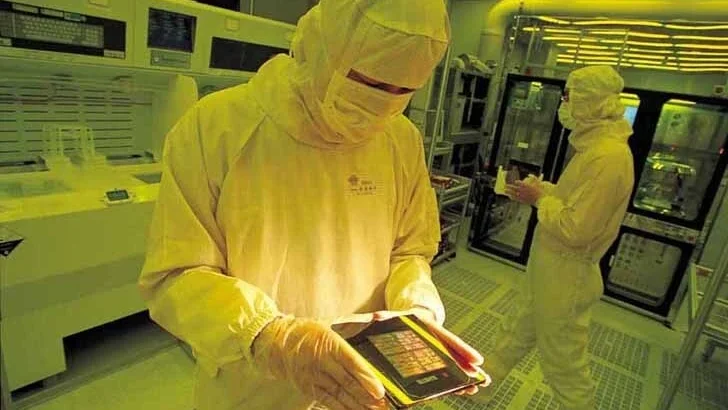We really don’t expect to see the 6G takeover in the U.S. until 2030. While that sounds like it is far off in the future, it is only five years away! The necessary planning and meetings required to determine standards for the next generation of wireless connectivity have started. Organizations such as the International Telecommunication Union (ITU-R) and the 3rd Generation Partnership Project (3GPP) have already started to work on 6G. The latter devises the technical standards for 6G, while the former handles the framework and vision for “IMT-2030,” the official name for 6G.
The first “all-frequency chip” was created in China


A worker examines chips in a foundry’s molding room. | Image credit-unknown
Right now, different devices run over different frequencies. Some smartphones run on mid-band 3GHz signals compared to the high-band (aka mmWave) 30GHz that satellite communications use. Future use of 6G for things like holographic surgery could require 6G signals traveling on the 100GHz band. Currently, it would take nine separate radio systems to cover the entire wireless spectrum of 0.5 GHz to 115 GHz. The new component developed in China supports all those frequencies in a thumbnail-sized chip.
“A single chip now replaces what once required multiple dedicated devices, truly achieving multipurpose programmability and dynamic frequency adjustment. It strikes an unprecedented balance between size, power consumption and performance.”
-Shu Haowen, author from Peking University
The component will also switch seamlessly across spectrum and will support communications running over mmWave and terahertz. So let’s stop for a second and reiterate what this chip can do. Instead of requiring different chips for different frequencies, this one chip will work with low-frequency signals under 6GHz, high-band mmWave frequencies, and even higher-band terahertz frequencies.
With the ability to switch between these frequencies seamlessly, users will be able to have a strong signal in any environment. For example, a device powered by this chip could go from using low-band in a rural area to running over a mmWave frequency in the city. Now, you might say that today’s phones allow you to move from low-band to mid-band to mmWave frequencies, and that is true.
But while a smartphone might have a single modem chip to process data, the radio-frequency (RF) part of the system is actually made up of transceivers, power amplifiers, and antenna modules for each separate frequency range (low-band, mid-band, and mmWave). The breakthrough discovered in China will allow a small thumbnail-sized component to run on the entire breadth of the wireless spectrum from 0.5 GHz to 115 GHz. This could lead to the development of smaller, versatile, and more power-efficient mobile devices.
Speaking to the media in China, Peking University Professor Wang Xingjun said, “There is an urgent need to tackle 6G development challenges. As the demand for connected devices grows rapidly, next-generation networks must leverage the strengths of different frequency bands. High-frequency bands such as millimetre-wave and terahertz offer extremely large bandwidth and ultra-low latency, making them suitable for applications like virtual reality and surgical procedures.”
The chip delivered data speeds approximately 100 times faster than peak consumer 5G in the U.S.
The functional part of the chip measures 11mm by 1.7mm (0.4 by 0.07 inch) and the quality of the communication was stable and smooth across the entire wireless spectrum. 6GHz frequency tuning, or the time it took to change from one frequency to another, was faster than 180 microseconds. That is hundreds of times faster than the blink of an eye.
Single-channel data speeds were faster than 100Gbps. Compare that to the 20Mbps average rural mobile download data speed in the U.S. Peak download data speeds for 5G users in the States are a little north of 1Gbps. That means that the new chip could deliver download data speeds close to 100 times faster than what some smartphone users in the States currently experience. The chip also has a feature that will allow it to find a “clear channel” if there is a situation where a particular frequency is blocked.
Next up for the team working on the chip is the development of plug-and-play smart communication modules that would be the size of a USB drive and would be embedded into smartphones, base stations, drones, and other devices. The chip could also lead to the creation of AI-driven wireless networks.


“Iconic Phones” is coming this Fall!
Good news everyone! Over the past year we’ve been working on an exciting passion project of ours and we’re thrilled to announce it will be ready to release in just a few short months.
LEARN MORE AND SIGN UP FOR EARLY BIRD DISCOUNTS HERE
#China #develops #breakthrough #chip #blows #todays #1Gbps #peak #consumer #experience

